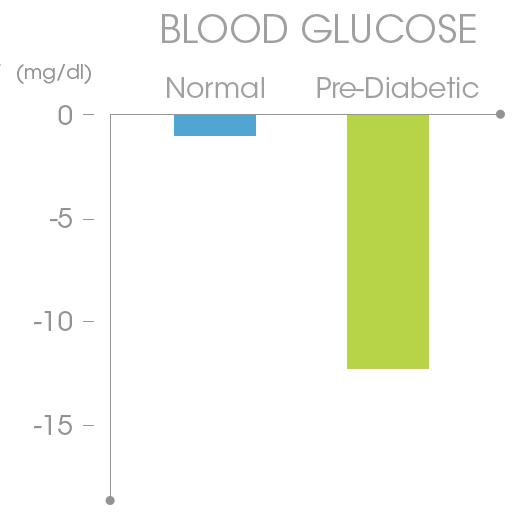“A diet designed to imitate the effects of fasting appears to reverse diabetes, a new USC-led study shows.”
“The fasting-like diet promotes the growth of new insulin-producing pancreatic cells that reduce symptoms of Type 1 and Type 2 diabetes in mice.”
“Cycling a fasting-mimicking diet and a normal diet essentially reprogrammed non-insulin-producing cells into insulin-producing cells,” said Valter Longo, a professor of biological sciences at the USC.
– USC News, February 24, 2017

Adopting the Longevity Diet can help prevent and has the potential to reverse diabetes in some patients. Not only will it help you maintain or reach a healthy weight and abdominal fat level –especially when combined with the exercise guidelines in The Longevity Diet– but it also may reduce diabetes incidence independently of weight.
People affected by pathologies may not do the FMD, unless they have the prior approval of their specialized doctor. In the case of serious or relatively serious illnesses (cancer, diabetes, or cardiovascular, autoimmune, or neurodegenerative diseases), it is important to seek permission and approval from a disease specialist as well as from a dietitian with expertise in the FMD or in therapeutic fasting. The use of the FMD for disease treatment should for the moment be limited to clinical trials unless the doctor determines that there are no viable options and the patient cannot wait until the conclusion of appropriate clinical trials and FDA (US Food and Drug Administration), and similar agencies in other countries, approval.


Diabetes drugs will interfere with or activate enzymes that can lower blood-glucose levels, but they will not target the multiple root causes for diabetes—some of which are understood and some of which are still emerging. The results of our 100 patient randomized clinical trial are very promising: they show that undergoing three monthly cycles of the five-day FMD formulated to mimic fasting (750 to 1,100 calories per day) will lower many of the major risk factors for diabetes and metabolic syndrome, which increases the risk for heart disease, diabetes, and stroke.
Overweight people have seen a drop of over 3.5 kg in weight and a reduction in abdominal fat, resulting in a thinning of the abdominal circumference of more than 2.5 cm, with no or minimal reduction in muscle mass.
In people with elevated IGF-1 levels, which could be a risk factor for diabetes, it is significantly reduced.
In pre-diabetic subjects it lowers fasting blood sugar by about 12 mg/d: in practice a decrease of more than 11%, therefore 2 to 3 times greater than that obtained with other more rigorous and much more impacting diets, such as 5:2 and the alternate-day fasting diet.
In people with high lipidic levels, it lowers triglycerides which are a risk factor for type II diabetes.
In hypertensive subjects, it lowers systolic and diastolic blood pressure up to 6%. High blood pressure is another risk factor associated with diabetes.


Scientists are wary of the word “cure” because it sounds like an exaggeration. However, for some patients with type 2 diabetes and the great majority of pre-diabetic patients, the combination of the dietary interventions described above could lead to a cure. The mouse and human data indicate that some and potentially many patients who follow the chronic dietary changes outlined in The Longevity Diet, or the periodic FMD, and preferably both, could eventually be free of type 2 diabetes, especially if treatment begins right after the initial diagnosis, when the pancreas is still functioning well.
Note that the combination of diabetes drugs and fasting or fasting-mimicking diets is dangerous and should be attempted only as part of a clinical trial.
All the data, including clinical data, underline the high potential of these dietary changes in effectively treating diabetes. However, this will have to be demonstrated in a large randomized clinical trial and approved by the FDA before it can be prescribed to patients instead of standard-of-care drugs for diabetes treatment. In the meantime, dietary interventions can serve as support to FDA-approved therapies.

Reducing abdominal and liver fat.

Promoting fat loss without muscle loss.

Cell renewal/regeneration and autophagy.

A recent study showed that cycles of the FMD, in addition to improving the function of insulin, could promote the regeneration of insulin-producing beta cells and the reversal of both type 1 and type 2 diabetes symptoms in mice in which the pancreas could not generate sufficient insulin, resulting in very high glucose levels. Remarkably, the FMD caused the activation of many pancreatic genes normally activated during embryonic/fetal development, suggesting that it can trigger a natural and highly coordinated regenerative response able to result in new and functioning beta cells, which can produce normal levels of insulin.
Multiple cycles must be completed with the approval and close monitoring of a doctor, preferably one who specializes in prolonged fasting therapies. Several potential side effects can result if the diet is followed improperly or if the wrong foods are consumed. Those side effects include an excessive drop in blood pressure or blood glucose, and malnourishment (deficiencies in certain vitamins, minerals, or essential nutrients). FMD can also produce a number of potential drug interactions, making a prolonged approach dangerous to some—for example, people receiving insulin therapy.
Another concern is related to weight fluctuations. Multiple studies have shown that cycles of major weight loss followed by major weight regain can increase cardiovascular disease in both normal subjects and those already suffering from heart disease.
It is therefore particularly important to avoid weight losses and regains. Patient must be committed to continuing the FMD once a month after undergoing multiple consecutive FMD cycles. We are now working toward performing clinical trials as part of the FDA approval process, but it takes time.
“In effect, the diet reduced the study participants’ risks for cancer, diabetes, heart disease and other age-related diseases, according to the findings published Feb. 15 in Science Translational Medicine.”
– USC News, Feb 16,2017
Legal Disclaimer
The information provided on this site is intended for your general knowledge only and is not a substitute for professional medical advice or treatment for specific medical conditions. You should not use this information to diagnose or treat a health problem or disease without consulting with a qualified healthcare provider. Please consult your healthcare provider with any questions or concerns you may have regarding your condition.
Le informazioni fornite su questo sito sono destinate esclusivamente alla vostra conoscenza generale e non sostituiscono la consulenza medica professionale o il trattamento per specifiche condizioni mediche. Non utilizzare queste informazioni per diagnosticare o curare un problema di salute o una malattia senza consultare un operatore sanitario qualificato. Si prega di consultare il proprio operatore sanitario per qualsiasi domanda o preoccupazione che si possa avere riguardo alla sua condizione.